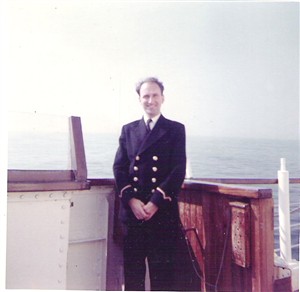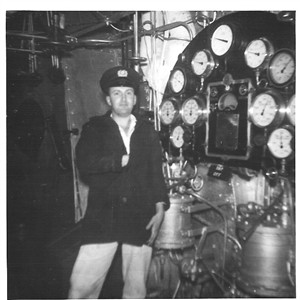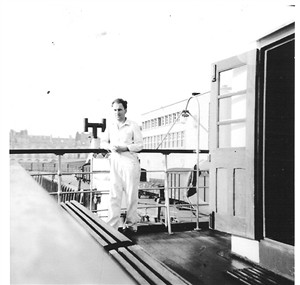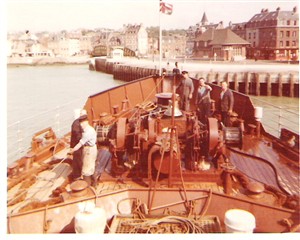T.S BRIGHTON VI

Me on the starboard wing of the bridge
From the private collection of Bryan Berry

By the gauge board in the boiler room.
From the private collection of Bryan Berry

Entering Newhaven.
From the private collection of Bryan Berry

On the fore deck heaving off the quay in Dieppe, then departing.
From the private collection of Bryan Berry
Memories of life and work on board.
By Bryan Berry
I sailed on the T.S Brighton VI for 10 years from 1952-1962 as a third or a fourth enginer officer having previously done approximately 2 years on the S.S Worthing.
My working hours were spent down below in either the engine room or the boiler room.
Brighton VI had two Foster-Wheeler ‘D’ type boilers supplying steam at 500 p.s.i. superheated. Each boiler had 7 oil sprayers or burners. It was a closed boiler room i.e. it was pressurised by air delivered by two high speed steam turbine driven fans. Also in the boiler room was a domestic boiler with tumble tubes at about 100 psi. It supplied steam to heat exchangers for all the ship’s hot water. It also supplied steam to a distiller. This was making distilled water for the main boilers because feed water could not be over a certain density otherwise the boilers would ‘prime’, i.e. water would be carried over to the turbines causing damage. On a crossing at full speed 20 tons of fuel oil could be consumed.
She was twin engined with reduction gearing. The turbine turned at about 3000 rpm with a shaft speed about 300 rpm. Each main engine turbine was PAMETRADA single casing type with an underslung condenser. PAMETRADA is an anacronym for PARSONS MARINE ENGINEERING TECHINICAL RESEARCH AND DEVELOPMENT ASSOCIATION. Besides having two turbo-generators she also had a five cylinder ‘Peter Brotherhood’ sleeve valve diesel engine which would be started up first thing and stay running and supplying electrical power until steam came up to pressure in the main boilers. Then, the turbo generators would be ‘run up’ and they would supply all the power, then the diesel generator would be shut down.
It would be started again about 10 minutes before entering port when all turbo generators would be switched on the switchboard. When ’finished with engines’ was rung down all steam was shut off and the diesel generator would remain running until the ship had been swung and then the shrore electrical supply was coupled up then the diesel was shut down.
On arriving in Dieppe or Newhaven all steam would be shut off and the diesel generator would supply all the electrical power until the passengers were discharged and any cargo lifted off. Then the ship would be cleaned, decks hosed down and the ship would be swung round by wires ready for the next departure. After swinging and mooring the diesel generator would be shut down and we would couple up to an electrical shore supply.
In the evenings in Dieppe some men went ashore to their favourite bar or bars, some stayed aboard and played cards and on one night in the week we would have an evening of ‘Tombola’ on shore known as Bingo. The bar that I and other engineers and mates used mostly was the Café Suisse. Of course there were others we used to visit such as ’Tout va Bien,’ ‘L’Univers’, ‘Ronnie Caprin’s’, ‘The Celtic’ and ‘Tribunaux’!
In mid-summer on very light evenings French summertime was one hour ahead of us. We would take long walks west to Saint Marguerite or Varengeville and one long walk east was to Berneval. There was a plaque leading down to the shore commemorating a during a commando raid where an American ranger was killed, the first American to die in Europe.
We also went on lots of shorter walks to places like Hautot, which had a church with a twisted spire, Arques-la-Battaille with its ruined castle and Puys where the Royal Regiment of Canada had terrible losses. There was a memorial to them down by the beach in the form of a gun emplacement.
When we walked to Puys through the back streets and arrived on the top of the cliff by the fishermen’s church, if Jacques Duchossoy was with us sometimes we would visit his father who lived close by.
Other walks were to ‘Le Pollet’ over the swing bridge past the old prison and past the shipyards where quote sizable steel trawlers were built. If we continued up through the docks past the warehouses quite a lot of bananas were kept , brought in quite regularly by Fred Olsen cargo ships. We would then come back to the ship via the racecourse.
In bad weather we would try to maintain our best possible speed but sometimes we would have to ease down because she would roll alarmingly. Down below in the engine room we would hang on waiting for one of the turbines to overspeed and cut out. We could carry up to 1,100 passengers and I think at least half of them were seasick. In those days you did not have sick bags, just papier mache bowls or a lot just used the deck. When it became unpleasant down below, passengers would crowd up on the boat for fresh air where they would get soaked with spray and sometimes vomit. When we watched passengers going ashore after a bad trip we would say, ’There's another 1,000 people who won’t travel on this ship again’. There were no stabilisers fitted.
Navigating officers I sailed with were: Captain Ernie Hills, Captain Vic English, Captain Ernie Beal, Michael Meardon, George Baldry and Edwin Groves.
Electrical Officers: Bill Brown, Joe Twanley
Chief Steward: Curly Palmer,
2nd Steward: Reg Sales
Radio Officers: Arthur Shepperd and sometimes he was relieved by Charlie Kelly.
Pursers: George Wood, Leslie Legg, Laurie Wren
‘Down below’ staff that I can remember are:
Engineers: Walter ‘Jockey’ Fenner, Harley Winder, George Newman, Norman Coleman, David Groves, Jacques Duchossoy, Bob Gibson, John Gulbransen, Barry Gilbert and Ron Dusart.
Greasers at the time: Pinky White, Billy Curd, Jack Hodgson, George Guy, Dave Eager, Jim.
Firemen: Len Andrews, Ray Ford, Ray Griffiths, Jimmy Green.
The firemen, greasers and and A.B.’s all had their own mess right aft, they also had their own galley which was at the stern. After leaving port one of my jobs was to check the main steering. In doing so I had to pass the crew’s galley which was very often manned by Newt Hardy (cook). I used to enjoy sampling one or two of his roast potatoes.
Officers did not have their own mess. We would eat in the main dining room on a six sided table in the port aft corner.
Sometimes after docking and pasengers disembarked we would get a visit from H. M. Customs. This was the ‘rummage squad’ dressed in blue overalls. They would search through all parts of the ship including down below in the engine and boiler room where they would lift up the deck plates to search in the bilges.
One would think that the master would tell the Chief Engineer the speed that he wanted for the crossing but no, the Chief calculated the speed. On a normal crossing with favourable tides and conditions each propeller would turn approximately 57,000 revolutions so, depending on tides and conditions, you allowed either more or less total revolutions. Also another factor was if you could leave port early or late we very rarely left early. I think the maximum shaft speed was about 350 rpm, or b.p.s. (best possible speed).
In the late 1950’s there was a fire, whilst we were alongside in Dieppe. It started in a deep fat fryer in the galley aft and spread up behind the wood panelling on the aft stairway. It was soon extinguished without doing too much damage but at the enquiry afterwards it was realised that some of the crew did not know much about fire-fighting. So, thereafter in the winter when the ship was laid up some officers and ratings would be sent off to do fire training. On our first session was with Brighton and we did some at Lewes and more strenuous on at the M.N. Fire School in Liverpool. The most rigorous training was with the Royal Navy at their training Unit at H.M.S. Phoenix at Portsmouth.
Soon after the fire the ship went to Southampton to be fitted with a sprinkler system by the Railway Marine Workshops.